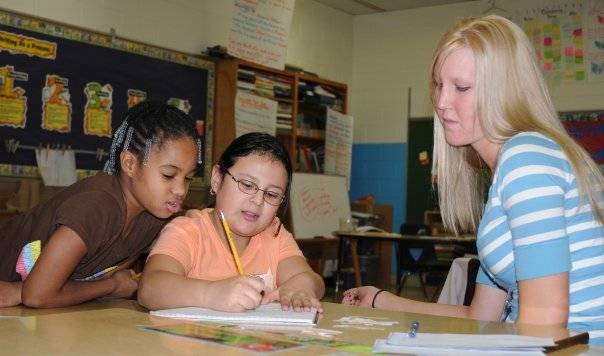This month’s volunteer spotlight is Danielle Berry, a Graduate Speech-Language Pathology student who is completing her coursework by doing unpaid work for the Champaign County Nursing Home. When I met Danielle, I was fascinated about what she does and about how she has decided on a different career path after volunteering for class, and I thought I would share her story.

Name: Danielle Berry
Age: 29
Location: Urbana, IL
Position Title: Graduate student in the Speech-Language Pathology program at the University of Illinois at Urbana-Champaign
Please explain how you got involved with the Champaign County Nursing Home and started your position.
To complete my clinical master’s degree in speech-language pathology, I am required to clock 400 hours in clinical practicum, (therapy with clients), in a number of areas of communication, (speech, language, and cognition), and swallowing. I was placed at the Champaign County Nursing Home this semester for my practicum work. I work alongside a certified Speech-Language Pathologist.
What are your normal duties while caring for the patients?
In the nursing home setting, many of the clients we work with are individuals with swallowing disorders secondary to a number of health problems. The SLP I work under performs a lot of swallowing evaluations and to assess an individual’s ability to safely and adequately intake food orally. In addition, we instruct patients on compensatory strategies, prescribe specific diet textures to maximize safety for oral intake and provide training to strengthen swallowing muscles. There are also individuals with communication problems that may include speech and language and/or cognition that can occur after a stroke, traumatic brain injury or dementia. There are a range of therapy techniques we use with these clients depending on the nature of their impairment.
What do you like the most about the work you do? Dislike most?
I love the ability to work with this population and aid in their recovery process. I also really enjoy the diagnosis process. Probably the hardest part about it is when you know you cannot help someone or that even if you can their problems are progressive and symptoms will worsen over time. It is still gratifying however to do what you can to help someone function at the highest level possible for their condition.
Any interesting stories you’d like to share?
For confidentiality reasons and the fact that I work in a therapy/medical based position, I don’t know that I can really share anything here.
How has this experience altered your career path?
I really went into this field to work with children. Since I have started I have been able to work with a number of different populations and in a number of different contexts. I knew I would enjoy working in the nursing home but I had no idea it would change my perspective on where I wanted to work after I graduated. I am definitely thinking about pursuing a career in a skilled nursing facility because of my experience at Champaign County Nursing Home and my amazing supervisor.
Do you have any advice for those who are interested in similar work?
Don’t be afraid to pursue areas of the field outside of those that you enter a program for. Before I started grad school, I had a very narrow view of what this field entailed. I think the diversity of the field is why I love it so much, and I really appreciate that everyone is required to experience all aspects of the field before they can be certified.
If you are a volunteer or know a volunteer who would like to be featured in the next article, then please email me. Thanks! –MER
An Introduction to Service-Learning
 According to the national Service-Learning website, Service-Learning is “a teaching and learning strategy that integrates meaningful community service with instruction and reflection to enrich the learning experience, teach civic responsibility, and strengthen communities”. Through service-learning, students are applying strategies learned in the classroom to real life scenarios, as well as giving back to their community in some way. This method is being used with students of all ages and studies have shown how when utilized, students have become more engaged and teachers have seen an overall improvement in grades. Service-learning is a win for all parties involved—students get a chance for hands-on work, teachers have an opportunity to have their students reflect on their engagement, and organizations have volunteers who are interested in doing meaningful work. An example of service–learning would be if teaching students, child development students, and other students interested in working with youth, were to mentor/tutor in a classroom for at-risk youth. Such programs exist all around the country and right here in Champaign-Urbana.
According to the national Service-Learning website, Service-Learning is “a teaching and learning strategy that integrates meaningful community service with instruction and reflection to enrich the learning experience, teach civic responsibility, and strengthen communities”. Through service-learning, students are applying strategies learned in the classroom to real life scenarios, as well as giving back to their community in some way. This method is being used with students of all ages and studies have shown how when utilized, students have become more engaged and teachers have seen an overall improvement in grades. Service-learning is a win for all parties involved—students get a chance for hands-on work, teachers have an opportunity to have their students reflect on their engagement, and organizations have volunteers who are interested in doing meaningful work. An example of service–learning would be if teaching students, child development students, and other students interested in working with youth, were to mentor/tutor in a classroom for at-risk youth. Such programs exist all around the country and right here in Champaign-Urbana.
For more information on Service-Learning, please see the following sites:
http://www.servicelearning.org/
http://www.aacc.nche.edu/Resources/aaccprograms/horizons/Pages/default.aspx
http://www.parkland.edu/academics/servicelearning.aspx
http://www.illinoiscampuscompact.org/

Disclaimer: I gather this information based on local community calendars and from colleagues at local service organizations. Some of the wording is based directly on what I receive and research. Please feel free to email me if you have any comments, questions, or have anything you would like to see posted. Thank you. (MER)








